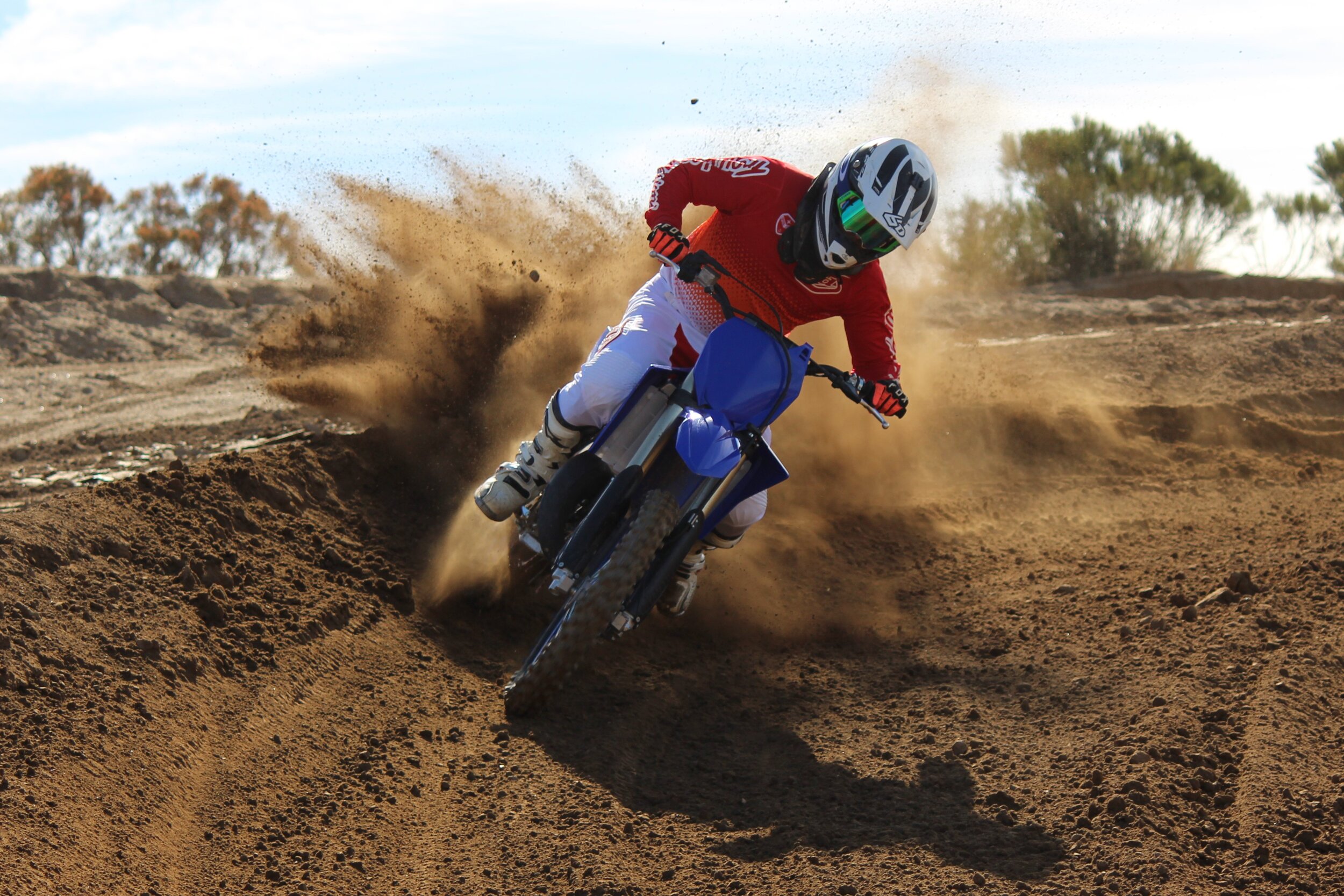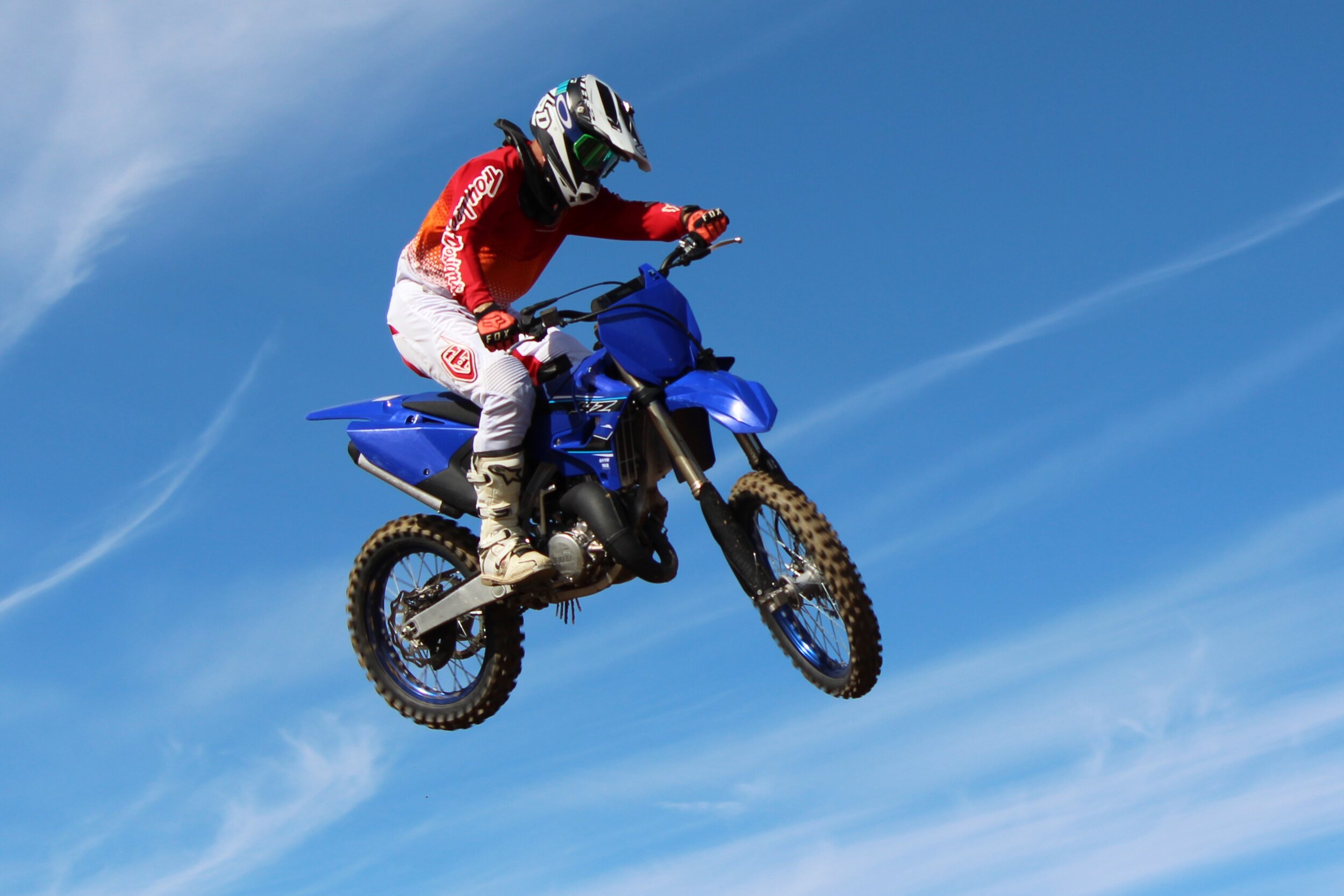Written By: Dr. Gardner Tarlow
Can the YZ 125X really serve as a multipurpose moto-enduro bike?
If you have read my previous article on the 2021 YZ 125x you know that Kris gave the average Joe rider (me) the opportunity to test the bike. Well luckily for me Kris asked me to continue to ride the bike and give him my extended impression.
I’ve had the opportunity to continue to ride the bike for a few months now. I had been thinking of adding a 125 MX machine to my stable of bikes for mid-week moto for a while, however seeing how I mainly rode enduro, I was hesitant to have a track bike that sat in my garage. When Yamaha first debuted the YZ 125X, I was excited and wanted to see how well the bike could handle the work load as a multipurpose bike. As luck would have it, Kris offered me the opportunity to test the 2021 YZ1 25X and I jumped at the chance. I instantly fell in love with this small-bore bike for both enduro and motocross and I have once again been bitten by the motocross bug.
I intentionally left the bike completely stock to hopefully get a better sense of the pros and cons as well as the reliability of this bike. This bike currently has 45 hours on it, approximately 20 hours on the trails and 25 hours at the track. I have only performed regular maintenance and played with suspension sag and clicker adjustments. The bike has continued to perform well and has been reliable on both the track and trail.
Not owning a newer 125 for the track to have as a yard stick, I felt this bike more than handled our local tracks and really didn’t give up much in track performance compared to a pure track bike. Recently however, I had the opportunity to ride back-to-back the YZ 125X and a stock 21 Husqvarna TC125. This was a bit of an eye opener for me as it took a bit of shine off the YZ 125X. I continued to prefer the YZs handling and rough track prowess, but the power difference pulling out of corners, down longer straights, and large hills was too much to turn a blind eye to. It would be interesting to ride the 125X back to back with the YZ125 to feel the difference.
In reality, I don’t know how important it is to compare the YZ 125X to a motocross track specific bike as that is not the designed purpose. In the same vein, I think it would be difficult to take a track specific 125 out into the hills, ride a rocky single track, with technical hill climbs/rock gardens for 2-3 hours and not feel completely beat up by the end of the ride. Each bike design serves a different purpose, especially when comparing the extremes of each riding discipline. The YZ 125X is designed to be a GNCC race bike, this means extended cross country, off road courses, and lasting 2-3 hours of racing. These courses will have sections which are tighter and potentially more technical than any motocross track and other sections that will be just as wide open as any motocross track or even short desert sections. Maybe the better question is which 125 can merge to perform all the different disciplines if you’re looking for a single 125 multipurpose bike.
When straight up comparing the YZ 125X wet weight to the other 125 motocross bikes the difference is between 2-10 lbs difference. The YZ 125X is still very light, flickable, easy to muscle around, and place into whatever line you want. Unfortunately, shedding weight on a bike can get expensive and when you consider the HP to weight difference, this may be slightly problematic at the track if you are competitively racing. For me however this isn’t a huge issue as I am looking to have fun on days off.
The power of the YZ 125X engine is smooth, very controllable and builds from off the bottom all the way up to its top end. The bottom end lugability allows the bike to perform very well on slow technical climbs as well as allow me to change lines when trying to maneuver over slow rocky obstacles. The delivery of the bottom end also allows you to roll on the throttle at very low speeds without having to abuse the clutch too much which is nice for an old doc like me. This also translates well for motocross allowing you to be more creative with inside lines and also makes up for some riding technique deficiencies. The mid-range is strong and more than capable with both riding disciplines and it hauls my 185 pound frame around well.. The top end of the YZ 125X seems to rev out sooner than I would like and fall off, leaving you wanting a little more top end. In stock form this is where the YZ 125X suffers the most compared to a track specific 125.
Modifying a YZ 125X to gain 6hp or more is possible, but at what cost to reliability as well as dollars. I don’t think I would mind pushing my YZ 125X back to the pits from the tracks edge, but it would make for a bad day of riding if you have to tow your bike back 2-3 miles away from your truck.
Although not a hydraulic clutch, I was pleasantly surprised at how well the stock clutch performed despite the abuse of both enduro and moto riding. The clutch had a light pull and continued to perform with minimal adjusting even on my most abusing days. Being at 45 hours the clutch held up well and although it will get a new clutch, I believe there are a few more good rides on the existing one.
The suspension on the 125X is essentially the same KYB setup as the YZ125 but with different valving, because of this, the YZ 125X has the potential to be as good as any YZ125. In its stock form it’s very ridable for the smaller rider, but at 185 pounds once you start getting aggressive or the track gets rougher, you notice the big hits in your wrists and feel the suspension moving thru the stroke too quickly. This unfortunately is going to be the case for all heavier riders, so re-valving the suspension front and rear with a stiffer spring rate is par for the course with any 125. In stock setting the suspension is just too soft for motocross unless you are the intended audience (<160lb) and even then, it is too soft for a faster rider when considering motocross. Out on the enduro trail and tight single track the suspension valving seems very appropriate soaking up rocky uneven surfaces, but again would need heavier springs for the larger riders.
Being more of an enduro guy and riding primarily a KTM 300XC, I felt the YZ 125X was a blast in the hills, single track and small rock gardens. Although the 125 is much easier to throw around and significantly lighter weight than my 300, you have to ride a 125 with much more aggression to get through certain types of sections. The same way it is a blast to attack at the track you need to do the same out in the hills. I definitely felt like I could manhandle and ride the more difficult sections better on the 125 but by the end of the 3 hour rides, this constant need to attack the trail left me feeling more fatigued compared to my larger bore bike. I will say I think the YZ 125X would be a great tool for any rider to improve and work on extreme enduro style techniques.
My wish list for this YZ 125X would be a gradual build up. I typically replace parts as they need servicing or I damage them. At 185 pounds without gear and 45 hours of ride time, the suspension needs servicing. I would service as well as address changing the spring rate and more aggressive valving to better handle weekday moto. I find it easier to soften suspension with clickers for enduro than stiffen suspension for moto. I occasionally drop or dare I say throw my bike out on the trail when in trouble, so bike armor for off-road is a must. At minimum the bike needs an aluminum rear disk guard, plastic front disc guard, skid plate, linkage guard, radiator guards and hand guards. The difference between a good running 125 and the same 125 finely tuned, can be significant. The carburetor performance in stock form seemed adequate, but I feel there is some performance gain to be had with a reed valve system. I wouldn’t mind adding a high compression head, pipe/silencer combo to even the playing field at the track. This would help overall power and hopefully provide a bit more top end without sacrificing too much bottom end performance. The front brake performance is average and although appropriate for both disciplines, an oversize front rotor and steel brake cable would be an improvement. The YZ 125X gas tank is the same as the YZ 125 at 2.1 gallons and although it has a reserve petcock, it doesn’t extend ride time or mileage. I spent most enduro rides carrying gas filled water bottles in my fanny pack so a larger tank would be optimal. Unfortunately, most available larger tanks (3.2 gallons) seem rather large for track purpose. Yamaha should have designed and provided a slightly larger 2.5 gallon tank (similar to the WR450F),which would have been perfect and still small enough for moto.
Without a doubt the YZ 125X can serve as a multipurpose 125. The more I rode this bike week to week, the more I appreciated what the YZ 125X could do out on the trail and at the track. Outside of competitive motocross, I believe the YZ 125X is a great alternative for someone wanting a 125 that can do it all with the least amount of difficulty going from one discipline to another.






